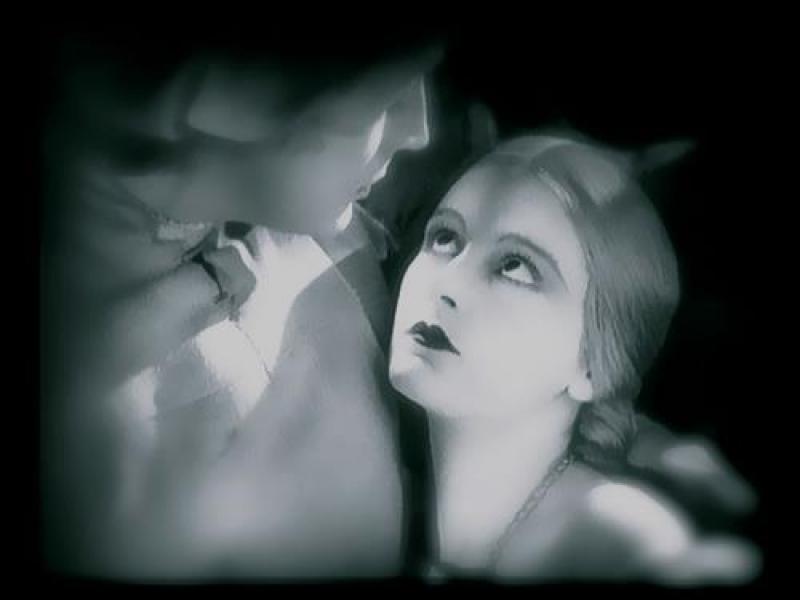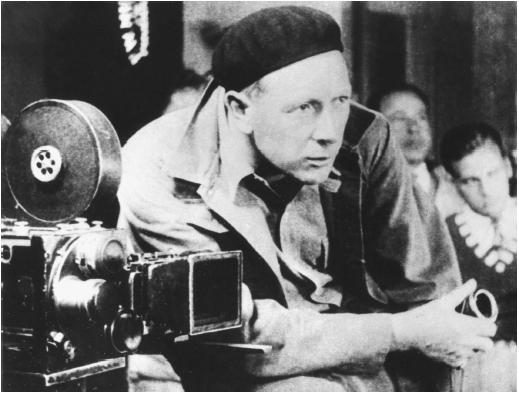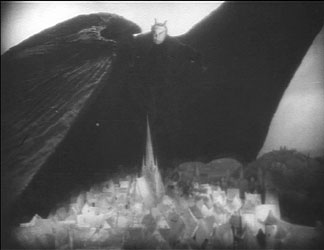FW Murnau's Faust, Royal Festival Hall | reviews, news & interviews
FW Murnau's Faust, Royal Festival Hall
FW Murnau's Faust, Royal Festival Hall
Greek composer premieres new score for silent-era classic

Silent movies are currently the rage of Tinseltown, so what better moment to brush up on one of the treasures of the pre-talkie era? Top movie-ologists now contend that FW Murnau's 1926 film of Faust is a neglected all-time great ("one of the most beautifully crafted films ever made," according to Theodore Huff in Sight & Sound).
Performed by the Philharmonia Orchestra under conductor Benjamin Wallfisch, and featuring piano soloist Gabriela Montero, Raickopoulou's sweepingly symphonic writing amplified the dramatic turbulence of Murnau's movie with a passion that would surely have impressed the director himself. An audience bristling with Greek royalty and socialites responded with appropriate ecstasy (Murnau at work, pictured below).
 But first, there was an introduction by a dinner-suited Hugh Grant, who is not (he explained) an expert on German expressionist film-making, but is however a friend and fan of the composer. Grant's droll chat roved freely over Murnau's career in Germany and subsequently Hollywood, and Raickopoulou's interest in his work. Richard Curtis could hardly have scripted it better, with its self-effacing asides about his imperfect acting skills and a Faust-evoking joke about David Cameron's pact with Andy Coulson. A shame, perhaps, that he kept calling Murnau "Gurnau", though even that was an improvement on his real name, Plumpe. Nor did Grant forget to hail the excellence of the orchestra, "with the exception of Jill on cor anglais, who's a bit dodgy."
But first, there was an introduction by a dinner-suited Hugh Grant, who is not (he explained) an expert on German expressionist film-making, but is however a friend and fan of the composer. Grant's droll chat roved freely over Murnau's career in Germany and subsequently Hollywood, and Raickopoulou's interest in his work. Richard Curtis could hardly have scripted it better, with its self-effacing asides about his imperfect acting skills and a Faust-evoking joke about David Cameron's pact with Andy Coulson. A shame, perhaps, that he kept calling Murnau "Gurnau", though even that was an improvement on his real name, Plumpe. Nor did Grant forget to hail the excellence of the orchestra, "with the exception of Jill on cor anglais, who's a bit dodgy."
As the room darkened and the film commenced with a trio of apocalyptic horsemen galloping through a stormy sky, it was immediately clear that this would be not so much a movie, more of a pre-psychedelic trip. Mid-1920s special effects were "digital" only insofar as everything had to be painstakingly devised and constructed by hand, but even so it wasn't hard to see how Faust was considered a benchmark in lighting, camerawork, effects and design. The scene where Faust and Mephisto fly across a landscape of mountains, villages and countryside (achieved by putting the camera on a kind of rollercoaster) was somehow far more affecting than a similar feat performed using a bank of super-computers would have been, while the sequence where a towering devil envelops the little town below in his enormous black wings and sends black plague-clouds billowing over the streets and houses was stupefying (pictured below).
 Raickopoulou's music mirrored the film's fantastical qualities with intensely-coloured string passages and some Wagner-esque brass, and wasn't afraid of a dollop of treacle for moments such as Faust's first romantic encounter with his beloved Gretchen or children dancing on the village green. Funereal piano and sombre violins greeted Faust's ill-judged decision to sign on Mephisto's dotted line.
Raickopoulou's music mirrored the film's fantastical qualities with intensely-coloured string passages and some Wagner-esque brass, and wasn't afraid of a dollop of treacle for moments such as Faust's first romantic encounter with his beloved Gretchen or children dancing on the village green. Funereal piano and sombre violins greeted Faust's ill-judged decision to sign on Mephisto's dotted line.
The acting wasn't quite as we know it today, even from Hugh Grant. Emil Jannings's gurning, pantomimic Mephisto often brought farce where soul-piercing dread was required, while Gösta Ekman's Faust was too much like a young and fey Gene Wilder for comfort. Nonetheless, this was still film-making of boundary-busting ambition, and now it has a fine new score to go with it. All that's lacking is a big wad of funding to get some repeat performances on the road.
Watch trailer for Murnau's Faust
Explore topics
Share this article
Add comment
The future of Arts Journalism
You can stop theartsdesk.com closing!
We urgently need financing to survive. Our fundraising drive has thus far raised £49,000 but we need to reach £100,000 or we will be forced to close. Please contribute here: https://gofund.me/c3f6033d
And if you can forward this information to anyone who might assist, we’d be grateful.

Subscribe to theartsdesk.com
Thank you for continuing to read our work on theartsdesk.com. For unlimited access to every article in its entirety, including our archive of more than 15,000 pieces, we're asking for £5 per month or £40 per year. We feel it's a very good deal, and hope you do too.
To take a subscription now simply click here.
And if you're looking for that extra gift for a friend or family member, why not treat them to a theartsdesk.com gift subscription?
more Film
 Blu-ray: Who Wants to Kill Jessie?
Fast-paced and visually inventive Czech comedy
Blu-ray: Who Wants to Kill Jessie?
Fast-paced and visually inventive Czech comedy
 Oslo Stories Trilogy: Love review - freed love
Gay cruising offers straight female lessons in a heady ode to urban connection
Oslo Stories Trilogy: Love review - freed love
Gay cruising offers straight female lessons in a heady ode to urban connection
 Beating Hearts review - kiss kiss, slam slam
Romance and clobberings in a so-so French melodrama
Beating Hearts review - kiss kiss, slam slam
Romance and clobberings in a so-so French melodrama
 Materialists review - a misfiring romcom or an undercooked satire?
Writer-director Celine Song's latest can't decide what kind of film it is
Materialists review - a misfiring romcom or an undercooked satire?
Writer-director Celine Song's latest can't decide what kind of film it is
 theartsdesk Q&A: actor Leonie Benesch on playing an overburdened nurse in the Swiss drama 'Late Shift'
The Guildhall-trained German star talks about the enormous pressures placed on nurses and her admiration for British films and TV
theartsdesk Q&A: actor Leonie Benesch on playing an overburdened nurse in the Swiss drama 'Late Shift'
The Guildhall-trained German star talks about the enormous pressures placed on nurses and her admiration for British films and TV
 Freakier Friday review - body-swapping gone ballistic
Lindsay Lohan and Jamie Lee Curtis's comedy sequel jumbles up more than their daughter-mother duo
Freakier Friday review - body-swapping gone ballistic
Lindsay Lohan and Jamie Lee Curtis's comedy sequel jumbles up more than their daughter-mother duo
 Eight Postcards from Utopia review - ads from the era when 1990s Romania embraced capitalism
Radu Jude's documentary is a mad montage of cheesy TV commercials
Eight Postcards from Utopia review - ads from the era when 1990s Romania embraced capitalism
Radu Jude's documentary is a mad montage of cheesy TV commercials
 The Kingdom review - coming of age as the body count rises
A teen belatedly bonds with her mysterious dad in an unflinching Corsican mob drama
The Kingdom review - coming of age as the body count rises
A teen belatedly bonds with her mysterious dad in an unflinching Corsican mob drama
 Weapons review - suffer the children
'Barbarian' follow-up hiply riffs on ancient fears
Weapons review - suffer the children
'Barbarian' follow-up hiply riffs on ancient fears
 theartsdesk Q&A: filmmaker Dag Johan Haugerud on sex, love, and confusion in the modern world
The writer-director discusses first-love agony and ecstasy in 'Dreams', the opening UK installment of his 'Oslo Stories' trilogy
theartsdesk Q&A: filmmaker Dag Johan Haugerud on sex, love, and confusion in the modern world
The writer-director discusses first-love agony and ecstasy in 'Dreams', the opening UK installment of his 'Oslo Stories' trilogy
 Oslo Stories Trilogy: Dreams review - love lessons
First love's bliss begins a utopian city symphony
Oslo Stories Trilogy: Dreams review - love lessons
First love's bliss begins a utopian city symphony

Comments
Marvellous trailer with
While allotting a paragraph
I agree it was a great
Yes what a lovely evening it
I just wanted to say how
Aphrodite Raickopoulou and
I personally thought Hugh
It is impossible to tell from
@anonymous (09/03). From what